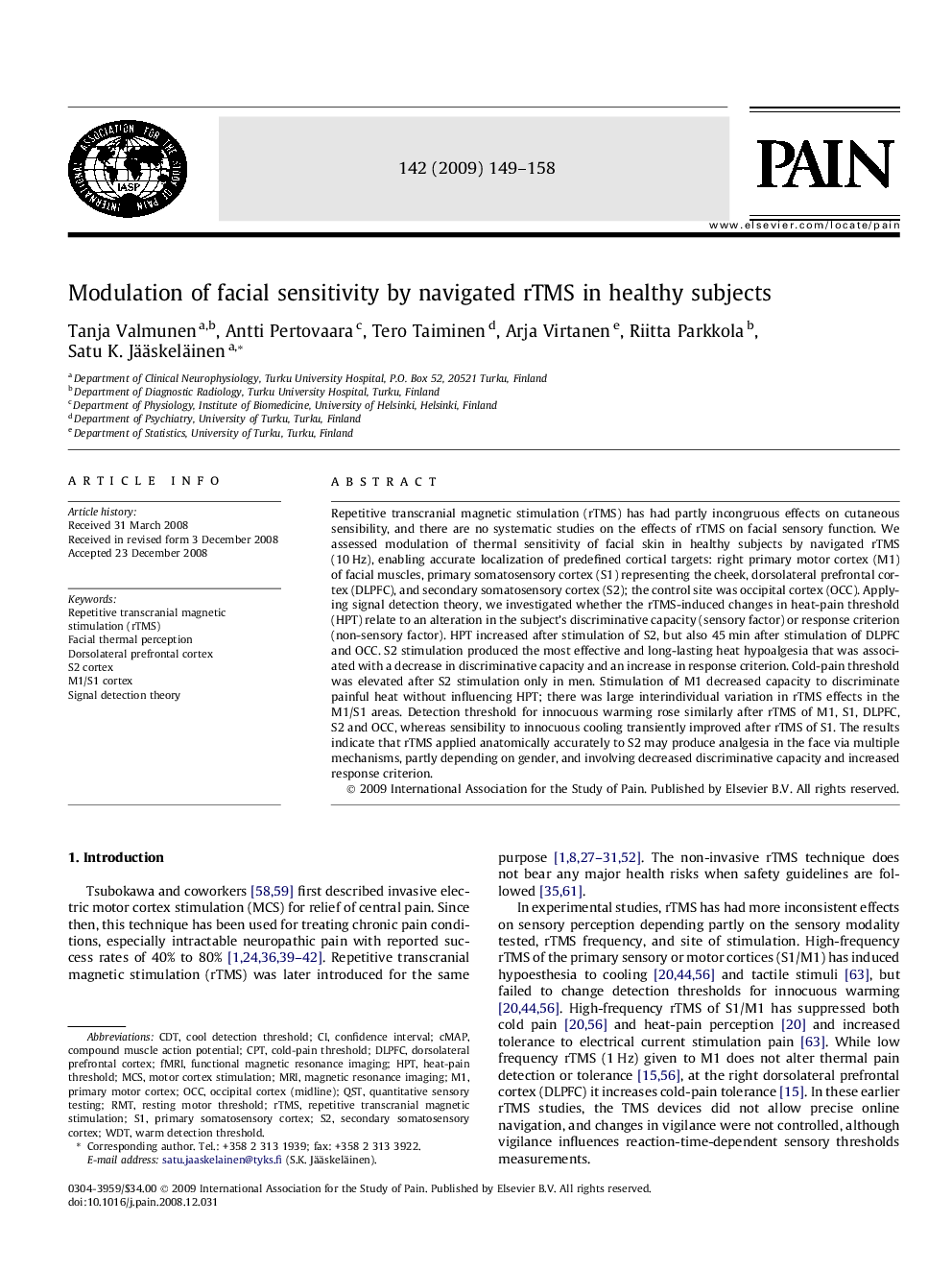| کد مقاله | کد نشریه | سال انتشار | مقاله انگلیسی | نسخه تمام متن |
|---|---|---|---|---|
| 914584 | 1473244 | 2009 | 10 صفحه PDF | دانلود رایگان |
عنوان انگلیسی مقاله ISI
Modulation of facial sensitivity by navigated rTMS in healthy subjects
دانلود مقاله + سفارش ترجمه
دانلود مقاله ISI انگلیسی
رایگان برای ایرانیان
کلمات کلیدی
WDTrTMSCPTMCshptCDTCMAPDLPFCRMTqst - QSTwarm detection threshold - آستانه تشخیص گرمresting motor threshold - استراحت آستانه موتورMRI - امآرآی یا تصویرسازی تشدید مغناطیسیSignal detection theory - تئوری تشخیص سیگنالmotor cortex stimulation - تحریک قشر مغزیRepetitive transcranial magnetic stimulation - تحریک مغناطیسی ترانس مغناطیسی تکراریRepetitive transcranial magnetic stimulation (rTMS) - تحریک مغناطیسی تکرار مغناطیسی تکراری (rTMS)Quantitative Sensory Testing - تست حساسیت کمیMagnetic resonance imaging - تصویربرداری رزونانس مغناطیسیfunctional magnetic resonance imaging - تصویرسازی تشدید مغناطیسی کارکردیfMRI - تصویرسازی تشدید مغناطیسی کارکردیOcc - عجبconfidence interval - فاصله اطمینانprimary somatosensory cortex - قشر اسموتیسنسوری اولیهprimary motor cortex - قشر حرکتی اولیهdorsolateral prefrontal cortex - قشر پیشانی غدد درون رحمیSecondary somatosensory cortex - قشر کمخونی ثانویهcompound muscle action potential - پتانسیل عمل عضله مرکب
موضوعات مرتبط
علوم زیستی و بیوفناوری
علم عصب شناسی
علوم اعصاب سلولی و مولکولی
پیش نمایش صفحه اول مقاله

چکیده انگلیسی
Repetitive transcranial magnetic stimulation (rTMS) has had partly incongruous effects on cutaneous sensibility, and there are no systematic studies on the effects of rTMS on facial sensory function. We assessed modulation of thermal sensitivity of facial skin in healthy subjects by navigated rTMS (10Â Hz), enabling accurate localization of predefined cortical targets: right primary motor cortex (M1) of facial muscles, primary somatosensory cortex (S1) representing the cheek, dorsolateral prefrontal cortex (DLPFC), and secondary somatosensory cortex (S2); the control site was occipital cortex (OCC). Applying signal detection theory, we investigated whether the rTMS-induced changes in heat-pain threshold (HPT) relate to an alteration in the subject's discriminative capacity (sensory factor) or response criterion (non-sensory factor). HPT increased after stimulation of S2, but also 45Â min after stimulation of DLPFC and OCC. S2 stimulation produced the most effective and long-lasting heat hypoalgesia that was associated with a decrease in discriminative capacity and an increase in response criterion. Cold-pain threshold was elevated after S2 stimulation only in men. Stimulation of M1 decreased capacity to discriminate painful heat without influencing HPT; there was large interindividual variation in rTMS effects in the M1/S1 areas. Detection threshold for innocuous warming rose similarly after rTMS of M1, S1, DLPFC, S2 and OCC, whereas sensibility to innocuous cooling transiently improved after rTMS of S1. The results indicate that rTMS applied anatomically accurately to S2 may produce analgesia in the face via multiple mechanisms, partly depending on gender, and involving decreased discriminative capacity and increased response criterion.
ناشر
Database: Elsevier - ScienceDirect (ساینس دایرکت)
Journal: Pain - Volume 142, Issues 1â2, March 2009, Pages 149-158
Journal: Pain - Volume 142, Issues 1â2, March 2009, Pages 149-158
نویسندگان
Tanja Valmunen, Antti Pertovaara, Tero Taiminen, Arja Virtanen, Riitta Parkkola, Satu K. Jääskeläinen,